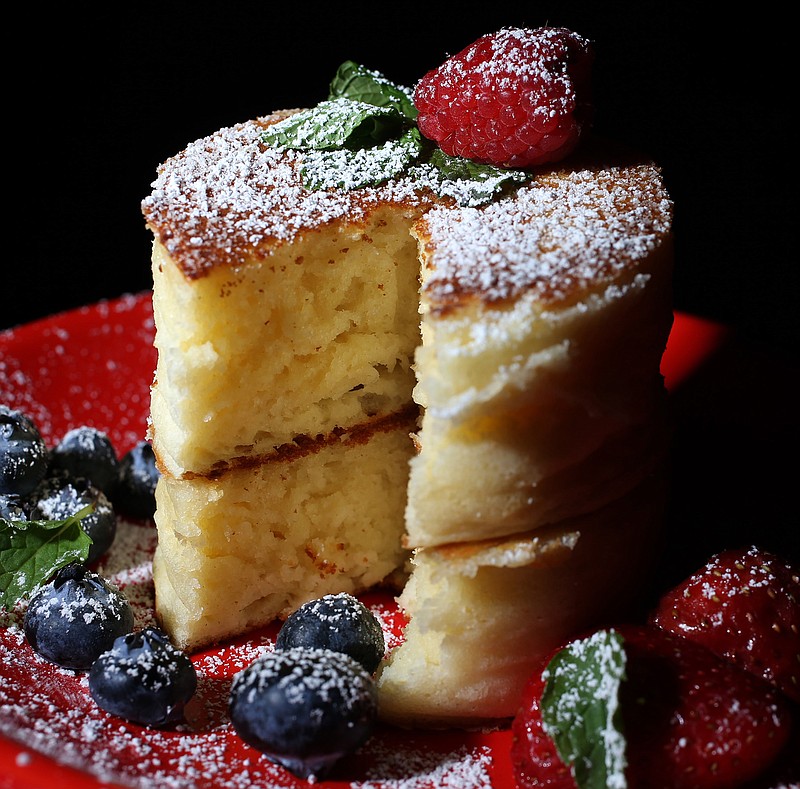A friend from out of town casually mentioned that he had eaten Japanese souffle pancakes, and then he went on talking as if nothing had changed.
Didn't he notice that the Earth had stopped turning? Didn't he see the hole that was burned through the fabric of our existence? Did he not realize that life as we had lived it up to this point had forever changed?
Three words was all it took for the world to turn upside down: Japanese souffle pancakes. And if you want to be technical, it was really only the "souffle pancakes" part. "Japanese" is just an intriguing modifier.
How had I not heard of Japanese souffle pancakes before? My entire life was a lie, and I did not even realize it.
Obviously, these were something I had to try. And because they do not serve them at Uncle Bill's Pancake House, I knew I was going to have to make them myself.
Make them I did, but first I had to buy a set of ring molds. These are like large napkin rings somewhere along the lines of 3 inches wide and 21/2 inches high. You can get them in many different sizes, but that's a good one for our purposes, or maybe a bit wider.
I bought mine at a restaurant supply store, but you can order them online. Or here's a cheaper alternative: Find a can of tuna fish that is about the right size, cut off the top, eat the tuna, cut off the bottom and clean it thoroughly. Voila - instant ring mold, plus you got to enjoy a nutritious lunch.
The ring molds were the easy part. The actual making of the souffle pancakes was a bit of a hassle, but only because something kept going wrong. I added essentially room-temperature melted butter into essentially room-temperature milk, and the butter immediately hardened into a raft of butter globules.
So I tried it the second time, and the same thing happened. That's when I reminded myself that, despite what you may see on the internet, Albert Einstein never actually said "the definition of insanity is doing the same thing over and over and expecting different results."
So I tried it a third time. And I got the same result.
I'm nothing if not persistent, occasionally, so I tried it a fourth time, but I used a different method. This time, I heated the milk and butter together just until the butter melted. Then I whisked this mixture into the egg yolk just a few drops at a time to keep the egg from scrambling.
After a couple of tablespoons' worth or so, I increased the hot (but cooling) liquid to a half-teaspoon, then three-quarters of a teaspoon, and so on. After I'd added maybe a quarter of a cup, I slowly added the rest of the milk/butter mixture, whisking all the time.
That technique, called tempering, worked like a charm.
There is only one other difference between souffle pancakes and regular pancakes, and that is the part that makes it a souffle. All you have to do is whip egg whites to stiff peaks - you can use a mixer; I used a whisk - and fold it gently into the rest of the batter.
Between the whipped eggs and some baking powder, you get pancakes that cook up remarkably tall, fluffy and light. They are absurdly delectable, and maybe just a touch more cake-like than ordinary pancakes. They feel like celebratory pancakes, the kind of thing to bring out on special occasions.
Powdered sugar is highly recommended. Syrup is essential.
Japanese Souffle Pancakes
Yield: 8 pancakes
1 1/2 cups all-purpose flour
3 tablespoons powdered sugar
2 teaspoons baking powder
1/2 teaspoon salt
1 1/4 cups milk
4 tablespoons butter cut into pieces
1 large egg yolk
1/2 teaspoon vanilla extract
3 large egg whites
1/4 teaspoon cream of tartar
Butter, maple syrup, powdered sugar for serving
Note: You will need 4 ring molds, each about 3 inches wide by 2 1/2 inches high.
1. In a large bowl, whisk together the flour, powdered sugar, baking powder and salt.
2. Heat milk and butter together in a saucepan over medium heat just until the butter melts. Place egg yolk in a medium bowl and whisk in just a few drops of the milk mixture at a time. Keep whisking and adding the milk mixture, gradually increasing the amount of milk mixture. Stir in the vanilla.
3. Beat the egg whites and cream of tartar together in another bowl until stiff peaks form, about 2 minutes.
4. Stir the milk mixture into the flour mixture until just combined (it's OK if there are a few lumps). Stir 1/3 of the beaten egg whites into the flour-milk mixture, then gently fold in the remaining egg whites until just combined, taking care not to overmix.
5. Lightly butter the inside of the ring molds or spray with nonstick spray.
6. Heat a large nonstick skillet over medium-low heat. Coat with butter or nonstick cooking spray. Place the prepared ring molds in the middle of the skillet and fill each with 1/2 cup of batter, filling each ring mold about halfway.
7. Cover the skillet with the lid and cook until the batter is golden on the bottom - it should rise to the tops of the ring molds, be covered with bubbles and jiggle only slightly when shaken. Using a spatula and tongs, carefully flip the ring molds. Cover and cook until golden on the other side.
8. Serve with butter and maple syrup and maybe some more powdered sugar.
Per serving: 211 calories; 8 g fat; 4 g saturated fat; 109 mg cholesterol; 8 g protein; 26 g carbohydrate; 7 g sugar; 1 g fiber; 213 mg sodium; 177 mg calcium
Adapted from a recipe by the Food Network Kitchen.

